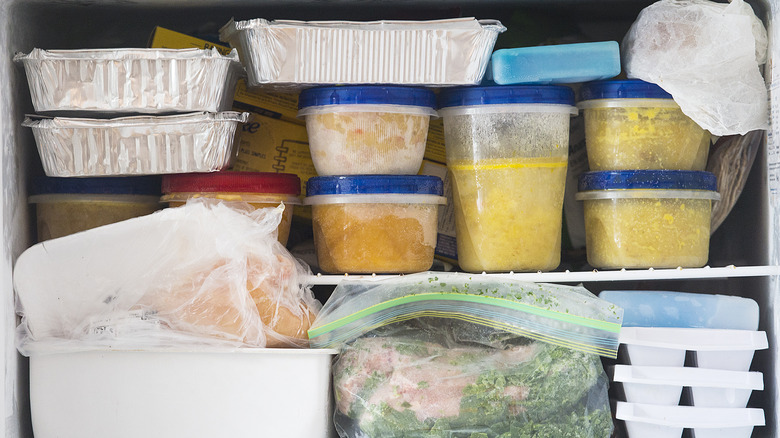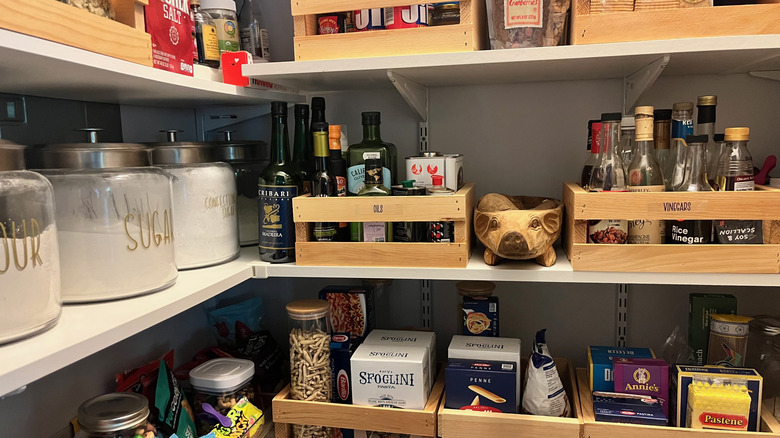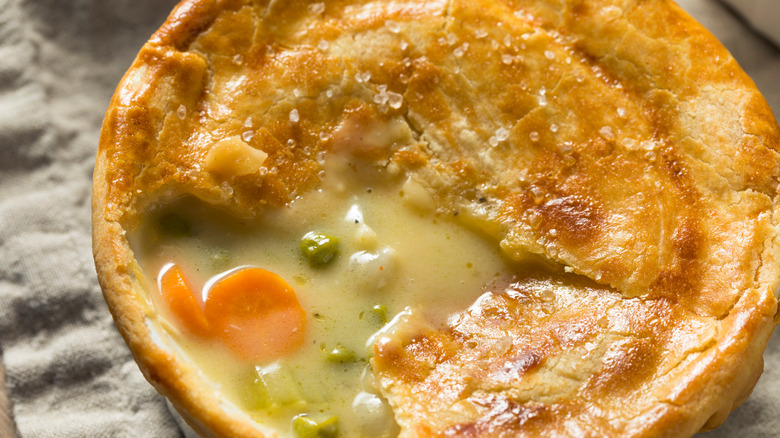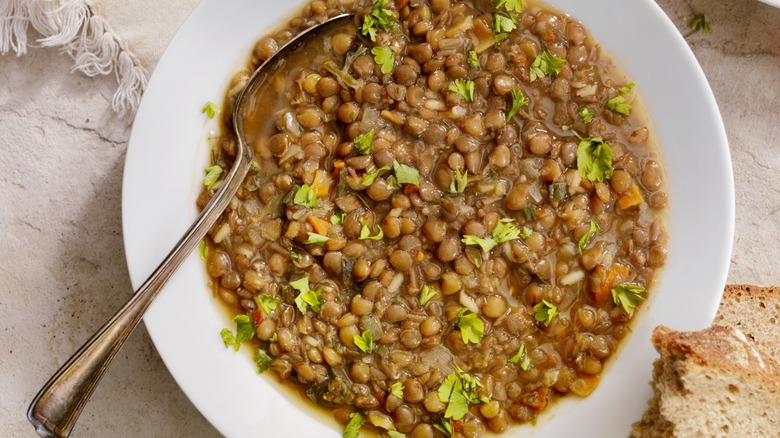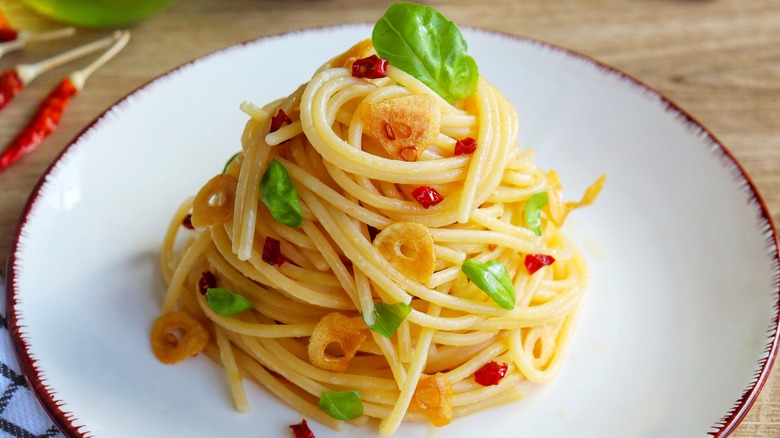Here's How I've Lived Off Of Nothing But The Food In My Pantry For Weeks
As a person who enjoys cooking and entertaining, my pantry is probably stocked more than the average household. Along with the necessities, including a collection of oils and finishing salts, my pantry is filled with food gifts from friends for the holidays or family from a vacation abroad, like bomba rice for paella from my daughter's trip to Spain.
Recently, when I became an empty nester, I realized I no longer needed to stock food to feed hungry teenagers and their friends regularly. I had too much on hand, and it felt wasteful. My cooking had changed, and my shopping habits needed to adapt, too, but first, I needed to get through what I had on hand, which could take weeks.
Beautifully packaged tinned fish, locally made jams, and ingredients to spontaneously throw together a charcuterie board filled the shelves. While I wouldn't need to replenish snack food and cereals I kept for the kids, it also meant that Sunday sauce required one 28-ounce can of plum tomatoes, not the six I always kept on hand to make large batches.
In the freezer, I've collected quarts of homemade marinara and bolognese sauce, soups, Parmigiano-Reggiano rinds, ice cubes made of wine I didn't finish, "just in case" loaves of banana bread, and meats that I purchased at Costco. I challenged myself to clean out the pantry and freezer, limiting trips to the supermarket, but I didn't realize how long this experiment would take.
I took an inventory of what I'm working with
To do this properly, I took inventory, noting the perishables that would compose my first few meals. Store-bought bread, green vegetables, and dairy like sour cream and ricotta needed to be eaten soon, while onions, potatoes, and gourds could wait. Aside from replenishing oat milk for my morning coffee and produce regularly, I had enough meat, grains, and baking supplies to last me for weeks or longer.
My pantry was filled with over a dozen pounds of pasta in my favorite shapes, like pastina, orecchiette, and bucatini. Although it would take me weeks to get through what I stocked, I also had plenty of semolina and 'OO' flour to make pasta from scratch when I ran out. The same was true for bread using the sourdough starter I started in 2020. Plus, a pasta subscription from my kids meant three more boxes would arrive soon.
Bulk ingredients like rice, beans, and nuts filled half-gallon mason jars, meaning I had plenty of protein once the frozen meat was consumed. I planned menus to keep meals interesting and maximize what I had on hand, sometimes assembling a smorgasbord of random ingredients to avoid food waste. A handful of crackers, dried fruit, a wedge of cheese, nuts, and honey made a surprisingly satisfying meal in a pinch.
My plan of attack
Since most of the meals I froze were meant to feed four people, I needed to be strategic, so I didn't have to eat a tray of lasagna all week. I saved meals frozen in large quantities for when my kids came home or I entertained.
Raw meats needed to be further divided once defrosted. That also included my favorite store-bought shortcut, Costco's rotisserie chicken breast meat. I had split the chicken into three one-pound bags, perfect for a family-sized chicken pot pie or soup, but now I needed to use each bag in four recipes to avoid getting bored with my meals. One pound of chicken became a salad, enchiladas, stir-fry, and lettuce wraps to keep menus interesting.
Since it was limited, meat became less of the star of the plate, forcing me to utilize more legumes and whole grains. At first, I felt something was missing, but I learned to use lentils and chickpeas in my recipes better and added eggplant and mushrooms to my grocery list to feel more satiated.
I still used bacon and pancetta to add umami and smokiness to dishes but in smaller quantities. I rolled and froze bacon strips to grab what I needed and kept the fat to flavor another dish. I prepared several servings of rice or quinoa at the beginning of the week to round out vegetarian meals or make fried rice to clean out any leftover meat or veggies I had in the fridge.
What I learned from this exercise
Since commercially prepared foods were the first to go, I occasionally missed a salty potato chip but ate more consciously and healthier. If I wanted chips, I enthusiastically deep-fried them myself, but this time-consuming and often messy process kept me from eating them each time I made a sandwich.
The most rewarding meals combined a bunch of scraps to make something delicious. The last shallot from my garden sautéed in the stored bacon fat, simmered with a cup of lentils, a squeeze of tomato paste, and a parmesan rind. In a rush, eggs were my go-to, scrambled with the veggies or a potato I had on hand and filled with herbs from my garden. These simple meals were comforting and enjoyable.
An unexpected benefit was how much less waste I produced. After the second week, my garbage and recycling bins, normally overfilling, were almost empty.
The hardest part was the planning. Meals took more thought and ingenuity as the days passed. While I got better at identifying what would taste good together, not every meal was a success, and it wasn't easy to host spontaneously, at least in the style I was used to. For a meal I prepared for some friends, I cheated and hit the supermarket because I wanted to serve fish. So, this plan wasn't flawless.
Cucina povera helped get me through
This exercise pushed me outside my cooking routine, forcing me to make the most of what I had, or 'l'arte dell'arrangiarsi,' which is at the heart of my grandmother's cooking style, cucina povera. Peasant cooking created personal favorites like ribollita and biscotti and the lesser-known comfort foods of my childhood, like pasta e lenticchie, which David Chang brilliantly calls "ugly delicious."
Before this, dinner could be subject to someone's cravings, ditching the prepped grilled chicken and salad for the Pasta Aglio e Olio I just watched Jon Favreau prepare for Scarlett Johansson in "Chef." Or, more recently, the omelet from "The Bear." Now, meals couldn't be as impulsive.
Small weekly grocery store trips were unavoidable but inspired me to plant a more extensive garden next spring. Although my pantry is pretty bare, and the freezer now holds a tray of lasagna and a package of Trader Joe's chocolate croissants that I'm saving for my kids, after four weeks, there's still plenty I can make with the ingredients I have on hand.
My day-to-day cooking is simpler but more satisfying in many ways. While I'd like to say that I'll stop filling the pantry with small-batch jars of honey I find at a farmer's market, it's unlikely since I enjoy discovering delicious food.
If my story sounds familiar because you love food or now cook for fewer people, take a second look next time you think there's nothing to eat. Chances are, there's a lot.

